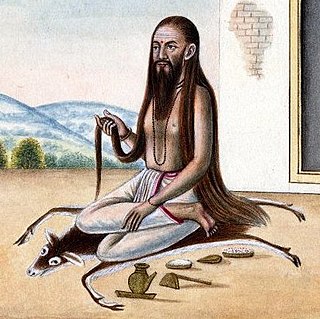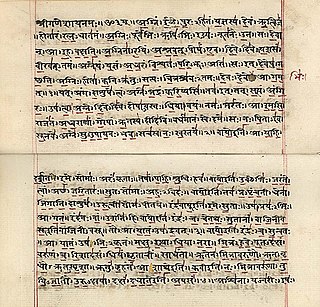Related Research Articles

Bharadvaja was one of the revered Vedic sages (maharishi) in Ancient India. He was a renowned scholar, economist, grammarian, physician and a follower of Maha Pashupata. He is one of the Saptarishis.

The historical Vedic religion, also known as Vedicism and Vedism, constituted the religious ideas and practices prevalent amongst the Indo-Aryan peoples of the northwest Indian subcontinent during the Vedic period. These ideas and practices are found in the Vedic texts, and some Vedic rituals are still practiced today. The Vedic religion is one of the major traditions which shaped Hinduism, though present-day Hinduism is significantly different from the historical Vedic religion.
The Shatapatha Brahmana is a commentary on the Śukla (white) Yajurveda. It is attributed to the Vedic sage Yajnavalkya. Described as the most complete, systematic, and important of the Brahmanas, it contains detailed explanations of Vedic sacrificial rituals, symbolism, and mythology.
Smriti, literally "that which is remembered" are a body of Hindu texts usually attributed to an author, traditionally written down, in contrast to Śrutis considered authorless, that were transmitted verbally across the generations and fixed. Smriti is a derivative secondary work and is considered less authoritative than Sruti in Hinduism, except in the Mimamsa school of Hindu philosophy. The authority of smriti accepted by orthodox schools is derived from that of shruti, on which it is based.

The Brahmanas are Vedic śruti works attached to the Samhitas of the Rig, Sama, Yajur, and Atharva Vedas. They are a secondary layer or classification of Sanskrit texts embedded within each Veda, which explain and instruct on the performance of Vedic rituals. In addition to explaining the symbolism and meaning of the Samhitas, Brahmana literature also expounds scientific knowledge of the Vedic Period, including observational astronomy and, particularly in relation to altar construction, geometry. Divergent in nature, some Brahmanas also contain mystical and philosophical material that constitutes Aranyakas and Upanishads.
The Aranyakas are a part of the ancient Indian Vedas concerned with the meaning of ritual sacrifice. They typically represent the later sections of the Vedas, and are one of many layers of Vedic texts. The other parts of the Vedas are the Samhitas, Brahmanas (commentary), and the Upanishads.
Vedic Sanskrit, also simply referred as the Vedic language, is an ancient language of the Indo-Aryan subgroup of the Indo-European language family. It is attested in the Vedas and related literature compiled over the period of the mid-2nd to mid-1st millennium BCE. It is orally preserved, predating the advent of writing by several centuries.

Yajna in Hinduism refers to any ritual done in front of a sacred fire, often with mantras. Yajna has been a Vedic tradition, described in a layer of Vedic literature called Brahmanas, as well as Yajurveda. The tradition has evolved from offering oblations and libations into sacred fire to symbolic offerings in the presence of sacred fire (Agni).
The Atharvaveda or Atharva Veda or Atharvana Veda is the "knowledge storehouse of atharvāṇas, the procedures for everyday life". The text is the fourth Veda, and is a late addition to the Vedic scriptures of Hinduism.

The Vedas are a large body of religious texts originating in ancient India. Composed in Vedic Sanskrit, the texts constitute the oldest layer of Sanskrit literature and the oldest scriptures of Hinduism.
Dharmaśāstra are Sanskrit texts on law and conduct, and refers to the treatises (śāstras) on Dharma. Unlike Dharmasūtra which are based upon Vedas, these texts are mainly based on Puranas. There are many Dharmashastras, variously estimated to be 18 to about 100, with different and conflicting points of view. Each of these texts exist in many different versions, and each is rooted in Dharmasutra texts dated to 1st millennium BCE that emerged from Kalpa (Vedanga) studies in the Vedic era.

Śrauta is a Sanskrit word that means "belonging to śruti", that is, anything based on the Vedas of Hinduism. It is an adjective and prefix for texts, ceremonies or person associated with śruti. The term, for example, refers to Brahmins who specialise in the śruti corpus of texts, and Śrauta Brahmin traditions in modern times can be seen in Kerala and Coastal Andhra.
A shakha is a Hindu theological school that specializes in learning certain Vedic texts, or else the traditional texts followed by such a school. An individual follower of a particular school or recension is called a śākhin. The term is also used in Hindu philosophy to refer to an adherent of a particular orthodox system.
The Baudhayana Shrauta Sutra is a Late Vedic text dealing with the solemn rituals of the Taittiriya Shakha school of the Krishna Yajurveda that was composed in eastern Uttar Pradesh during the late Brahmana period. It was transmitted both orally and through manuscript copying. It was printed in 1904-23 by The Asiatic Society, translated by C.G. Kashikar in part in his "Srautakosa", and as a whole later on. It was edited by Willem Caland.
Kalpa means "proper, fit" and is one of the six disciplines of the Vedānga, or ancillary science connected with the Vedas – the scriptures of Hinduism. This field of study is focused on the procedures and ceremonies associated with Vedic ritual practice.
The Taittirīya Shakha, is a shakha of the Krishna (black) Yajurveda. Most prevalent in South India, it consists of the Taittirīya Samhita ('TS'), Taittirīya Brahmana ('TB'), Taittirīya Aranyaka ('TA'), and Taittirīya Pratisakhya ('TP').
In Hindu culture, a Parivara refers to a system of identity, particularly a family line. The Pravar system is based on the descendants of a rishi (sage) after whom a "gotra" (clan) is named, and these descendants are considered eponyms by the members of the "gotra." It represents a secondary level of segmentation within the gotra system. The Pravara is a significant aspect of the exogamous system in ancient Brahmanical families.
Pariśiṣṭa are Sanskrit supplementary texts appended to another fixed, more ancient text – typically the Vedic literature – that aim to "tell what remains to be told". These have style of sutras, but less concise. According to Max Mueller, the parisista of the Vedas, "may be considered the very last outskirts of Vedic literature, but they are Vedic in character, and it would be difficult to account for their origin at any time except the expiring moments of the Vedic age."

The Rigveda or Rig Veda is an ancient Indian collection of Vedic Sanskrit hymns (sūktas). It is one of the four sacred canonical Hindu texts (śruti) known as the Vedas. Only one Shakha of the many survive today, namely the Śakalya Shakha. Much of the contents contained in the remaining Shakhas are now lost or are not available in the public forum. Rigveda Samhita was composed in the northwestern region of the Indian subcontinent.
In Hinduism, Śāstra pramāṇam refers to the authority of the scriptures with regard to puruṣārtha, the objects of human pursuit, namely dharma, artha, kāma (pleasure) and mokṣa (liberation). Together with smṛti, ācāra, and ātmatuṣṭi, it provides pramana and sources of dharma, as expressed in Classical Hindu law, philosophy, rituals and customs.
References
- ↑ President's Award (Rashtrapati Samman): Certificates of Honour: 15 August 2009
- ↑ List of Recipients of President's Certificate of Honour - 2009 Archived 2010-11-27 at the Wayback Machine
- ↑ "PRESIDENT'S AWARD FOR CLASSICAL SCHOLARS: Ministry of Human Resource Development, Govt. of India". Archived from the original on 30 January 2010. Retrieved 13 January 2011.
- ↑ List of Recipients of President's Certificate of Honour - 2009: RASHTRIYA SANSKRIT SANSTHAN Deemed University.
- ↑ "Bhavans.info". Archived from the original on 13 December 2010. Retrieved 7 March 2011.
- ↑ Reviews; Samiran Chandra Chakrabarti (ed.): Some Aspects of Vedic Studies.
- ↑ Buddhism and World Culture (ed.)
- ↑ New selections from the Brahmanas
- ↑ A Study of the Pariplava
- ↑ The paribhāòsās in the âsrautasåutras Archived 2011-06-29 at the Wayback Machine
- ↑ Brahmanasangrahah: Brahmanasamgrahah
- ↑ On the transition of Vedic sacrificial lore
- ↑ The Position of the "Paribhāṣās" in the Textual Order of the "Āpastamba Śrautasūtra"
- ↑ The Concept Of Purusarthas
- ↑ Apastamba-Samanya-Sutra or Yajnaparibhasa Sutra